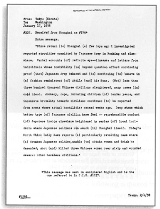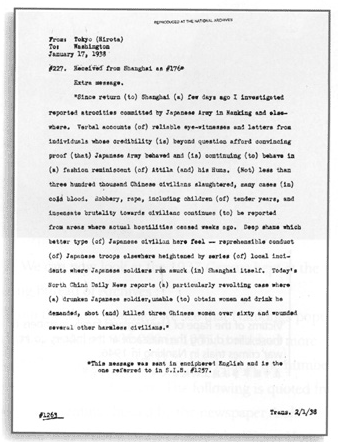
Nanjing War Crimes Tribunal
Encyclopedia

Chiang Kai-shek
Chiang Kai-shek was a political and military leader of 20th century China. He is known as Jiǎng Jièshí or Jiǎng Zhōngzhèng in Mandarin....
to judge four Japanese Imperial Army officers accused of crimes committed during the Second Sino-Japanese War
Second Sino-Japanese War
The Second Sino-Japanese War was a military conflict fought primarily between the Republic of China and the Empire of Japan. From 1937 to 1941, China fought Japan with some economic help from Germany , the Soviet Union and the United States...
. It was one of thirteen tribunals established by the Nationalist government.
The accused were Lieutenant General Hisao Tani
Hisao Tani
- Notes :...
, company commander Captain Gunkichi Tanaka and Second Lieutenants Toshiaki Mukai and Tsuyoshi Noda, made famous by the contest to kill 100 people using a sword.
General Yasuji Okamura
Yasuji Okamura
- Notes :...
was convicted of war crimes in July 1948 by the Tribunal, but was immediately protected by the personal order of Nationalist leader Chiang Kai-shek
Chiang Kai-shek
Chiang Kai-shek was a political and military leader of 20th century China. He is known as Jiǎng Jièshí or Jiǎng Zhōngzhèng in Mandarin....
, who retained him as a military adviser for the Kuomintang
Kuomintang
The Kuomintang of China , sometimes romanized as Guomindang via the Pinyin transcription system or GMD for short, and translated as the Chinese Nationalist Party is a founding and ruling political party of the Republic of China . Its guiding ideology is the Three Principles of the People, espoused...
(KMT).
While he was questioned by the investigators, he however testified about the Nanking massacre
Nanking Massacre
The Nanking Massacre or Nanjing Massacre, also known as the Rape of Nanking, was a mass murder, genocide and war rape that occurred during the six-week period following the Japanese capture of the city of Nanjing , the former capital of the Republic of China, on December 13, 1937 during the Second...
:
"I surmised the following based on what I heard from Staff Officer Miyazaki, CCAA Special Service Department Chief Harada and Hangzhou Special Service Department Chief Hagiwara a day or two after I arrived in Shanghai. First, it is true that tens of thousands of acts of violence, such as looting and rape, took place against civilians during the assault on Nanking. Second, front-line troops indulged in the evil practice of executing POWs on the pretext of (lacking) rations."
As Iwane Matsui
Iwane Matsui
was a general in the Imperial Japanese Army and the commander of the expeditionary forces sent to China in World War II. He was convicted of war crimes and sentenced to death by hanging by the International Military Tribunal for the Far East for responsibility over the Nanking Massacre.-Early life...
had been judged by the Tokyo tribunal; Prince Kotohito Kan'in, Kesago Nakajima
Kesago Nakajima
- Notes :...
and Heisuke Yanagawa
Heisuke Yanagawa
- Notes :...
had been dead since 1945; Isamu Cho
Isamu Cho
- Notes :...
had committed suicide and Prince Asaka
Prince Asaka
of Japan, was the founder of a collateral branch of the Japanese imperial family and a career officer in the Imperial Japanese Army. Son-in-law of Emperor Meiji and uncle by marriage of Emperor Shōwa , Prince Asaka was commander of Japanese forces in the final assault on Nanking , then the capital...
had been granted immunity by General Douglas MacArthur
Douglas MacArthur
General of the Army Douglas MacArthur was an American general and field marshal of the Philippine Army. He was a Chief of Staff of the United States Army during the 1930s and played a prominent role in the Pacific theater during World War II. He received the Medal of Honor for his service in the...
as member of the imperial family, Hisao Tani
Hisao Tani
- Notes :...
was the only officer prosecuted for the Nanking massacre
Nanking Massacre
The Nanking Massacre or Nanjing Massacre, also known as the Rape of Nanking, was a mass murder, genocide and war rape that occurred during the six-week period following the Japanese capture of the city of Nanjing , the former capital of the Republic of China, on December 13, 1937 during the Second...
. He was found guilty on 6 February 1947 and executed on 10 March by a firing squad. All the accused were sentenced to death in 1947.
According to the verdict of the Tribunal for Tani, on 10 March 1947, there were more than 190,000 civilians and Chinese soldiers killed by machine gun whose corpses were burned to destroy proof. Besides, we count more than 150,000 victims of barbarous acts buried by the charity organisms. We thus have a total of more than 300,000 victims.» This estimate was made from burial records and eyewitness accounts.
The death toll of 300,000 is the official estimate engraved on the stone wall at the entrance of the Memorial Hall for Compatriot Victims of the Japanese Military's Nanjing Massacre
Nanjing Massacre Memorial Hall
The Memorial for compatriots killed in the Nanjing Massacre by Japanese Forces of Aggression is the Memorial Hall for the people killed in the Nanjing Massacre by the Japanese army in and around the then capital of China, Nanjing, after it fell to the Imperial Japanese Army on December 13, 1937...
in Nanjing.

